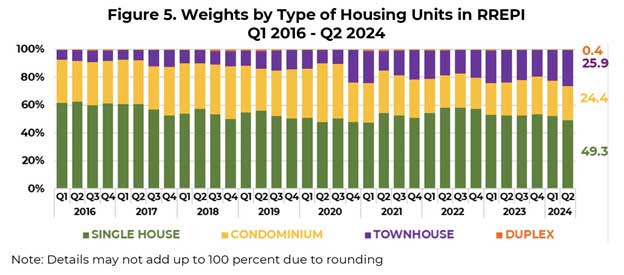Residential real estate prices of various types of new housing units in the Philippines continued to increase in Q2 2024.
Residential property prices rose by 2.7 percent year-on-year (YoY), albeit at a slower pace than the 6.1 percent growth in Q1 2024. On a quarter-on-quarter (QoQ) basis, housing prices grew faster at 1.8 percent than the 1.1 percent growth in Q1 2024 (Figure 1).

On a YoY basis, residential property prices in the National Capital Region (NCR) contracted by 1.0 percent in Q2 2024 with the decline in the prices of single-detached/attached houses outweighing the increase in the prices of townhouses and condominium units (Figures 1 and 2a).

By contrast, residential property prices in Areas Outside the NCR (AONCR) increased by 4.2 percent. This growth was driven by the annual price increases in duplex housing units, single-detached/attached houses, and condominium units, which surpassed the decline in townhouse prices (Figures 1 and 2b).

On a QoQ basis, residential property prices in the NCR and AONCR rose by 3.8 percent and 1.2 percent, respectively (Figure 1).
Prices rise across all housing types, except townhouses
By housing type (excluding the duplex housing units), condominium registered the highest YoY growth rate of 10.6 percent in Q2 2024, followed by a 1.7 percent growth in single-detached/attached houses. Meanwhile, townhouses registered a contraction of 0.8 percent (Figure 2c).2

On a QoQ basis, price increases across housing types in Q2 2024 were mixed. Prices of condominium units grew the fastest at 4.2 percent, followed by single-detached/attached houses at 3.2 percent, while duplex housing units and townhouses registered a 2.3 percent and 2.6 percent decline, respectively (Figure 2c).
Loan availments for new housing units decline
In Q2 2024, the number of residential real estate loans (RRELs) granted for all types of new housing units in the Philippines contracted by 3.5 percent YoY.
Specifically, loans granted in the NCR decreased by 9.2 percent, while those in AONCR declined marginally by 0.8 percent.
On a QoQ basis, nationwide housing loan availments fell by 15.1 percent, following the decline in the NCR and AONCR of 11.5 percent and 16.6 percent, respectively (Figure 3a).

The total number of RRELs granted in the Philippines3 decreased by 3.2 percent YoY, which reflected the 0.9 percent and 4.2 percent contraction in both the NCR and AONCR, respectively.
Similarly, the total number of transactions decreased by 9.9 percent QoQ as the 14-percent decline in the number of RRELs in AONCR negated the 1.4-percent growth in the NCR (Figure 3b).
In Q2 2024, the appraised value of new housing units in the country averaged to Php83,759 per square meter (sqm), registering 6.8 percent and 1.8 percent growth rates over the comparable year-ago and quarter-ago levels, respectively.
Similarly, the average appraised value per sqm in the NCR increased by 9.6 percent YoY and 5.6 percent QoQ to Php140,158 per sqm.
Meanwhile, the average appraised value per sqm in AONCR expanded by 7.8 percent YoY but declined by 4.0 percent QoQ to Php58,741. It may be noted that the average appraised value of properties in the NCR is more than twice than that in the AONCR (Figure 4).

The weight of each type of housing unit in the RREPI is determined by dividing the total floor area (in sqm) of a specific type of housing unit over the total floor area of all housing types.4
In Q2 2024, single-detached/attached houses continued to constitute the largest weight in the RREPI at 49.3 percent.
Meanwhile, townhouses, condominium units, and duplex housing units accounted for 25.9 percent, 24.4 percent, and 0.4 percent in the calculation of the RREPI, respectively (Figure 5).

In Q2 2024, 78.7 percent of residential real estate loan (RRELs) transactions were used to purchase new housing units.5
By type of housing unit, most of the residential property loans were used for the acquisition of single-detached/attached houses at 47.9 percent, followed by condominium units (32.5 percent), and townhouses (19.3 percent) as seen in Figure 6.

Most of the RRELs granted in the NCR were for the purchase of condominium units, while RRELs granted in AONCR were for the purchase of single-detached/attached houses. By region, 29.7 percent of the total number of RRELs granted were from the NCR.
The other regions, which contributed significantly to the number of RRELS granted, were as follows: CALABARZON (30.1 percent), Central Luzon (13.0 percent), Central Visayas (8.0 percent), Western Visayas (7.0 percent), Davao Region (4.4 percent), and Northern Mindanao (3.3 percent). The said regions, including the NCR, comprised 95.5 percent of the total housing loans granted by banks (Figure 6).
The RREPI is a measure of the average change in the prices of various types of housing units, i.e., single-detached/attached houses, duplex housing units, townhouses, and condominium units, based on banks’ data on actual mortgage loans granted to acquire new housing units (excluding pre-owned or foreclosed properties).
It is a chain-linked index, which is computed using the average appraised value per square meter, weighted by the share of floor area of each type of housing unit to the total floor area of all housing units.
The RREPI is used as an indicator for assessing the real estate and credit market conditions in the country. The BSP has been releasing the report since June 2016.
Data for the RREPI are obtained through BSP Circular No. 892 dated 16 November 2015, which requires all universal/commercial banks (UBs/KBs) and thrift banks (TBs) in the Philippines to submit to the BSP a quarterly report on all RRELs granted.
This was supplemented by the BSP Circular No. 1154 dated 14 September 2022, which requires all digital banks (DBs) in the country to submit similar reports to the BSP.
1 No index was generated for periods without bank loan transactions for duplex housing units in the NCR, as reflected by gaps in the series (orange line).
2 Despite the duplex housing units registering the highest YoY growth rates among housing types in Q2 2024, the number of transactions for duplex housing units was relatively low as it only accounts 0.33% of the 6,424 total number of new housing units sold in Q2 2024. Majority of said duplex transactions were high-value properties, which pulled the average upwards. Specifically, about 76% of the number of duplex loans granted had appraised values above the 3-year average of Php40,902 per sqm. Thus, for this section, the other housing types with a higher percentage of transactions (i.e., above 3%) were instead highlighted.
3 The total number of RRELs granted in the Philippines includes all transactions for new, pre-owned, and foreclosed housing units.
4 The weight is computed using loan transactions on new housing units only.
5 On the remaining residential housing properties purchased using RRELs in Q2 2024, 20.9 percent were pre-owned, while 0.4 percent were foreclosed properties.


















